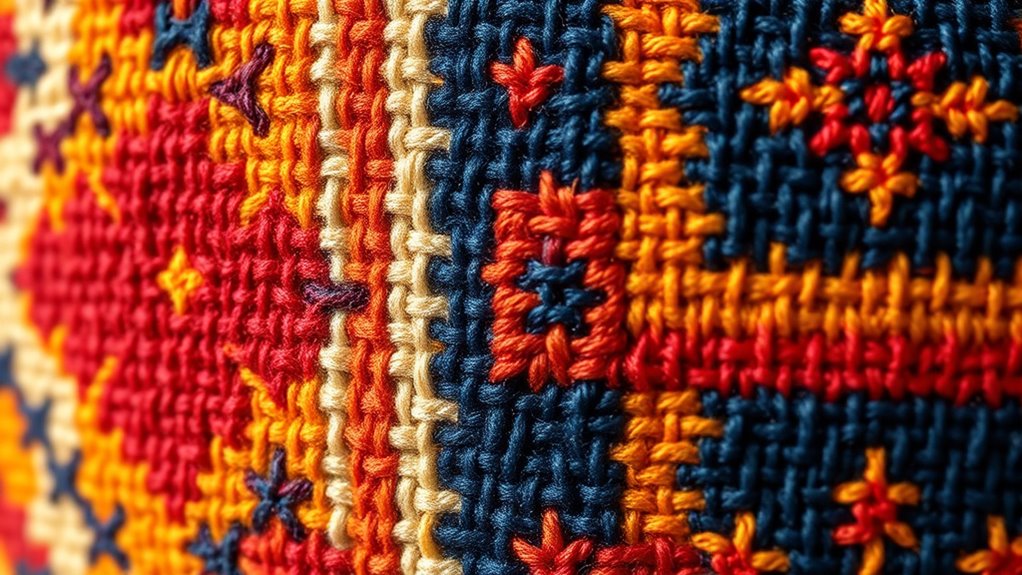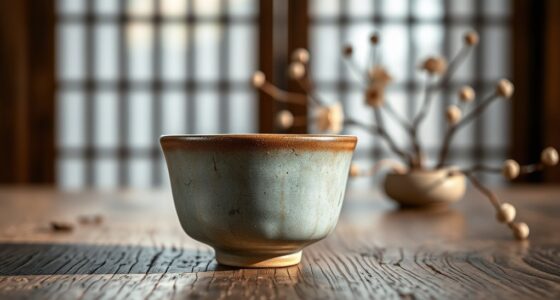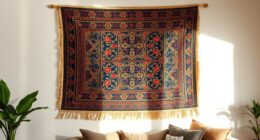Indigenous color palettes hold deep cultural meanings that reflect traditions, spiritual beliefs, and social identities. Colors like red symbolize life and vigor, while blue often represents peace or spiritual connection. When used thoughtfully in decor, these hues honor heritage and add authenticity. Respectful incorporation involves understanding their significance and supporting indigenous artisans. To discover more about the rich symbolism behind these colors and ways to honor them in your space, keep exploring these meaningful traditions.
Key Takeaways
- Indigenous color palettes consist of symbolic hues representing stories, spiritual beliefs, and social identities within communities.
- Colors like red, blue, green, and white convey meanings such as vitality, peace, nature, and purity.
- Traditional palettes are derived from natural resources and crafted through techniques like natural dyeing and weaving.
- Incorporating indigenous colors in decor honors cultural significance and promotes respectful appreciation of traditions.
- Supporting indigenous artisans ensures preservation of authentic color use and cultural heritage in modern design.
The Cultural Significance of Indigenous Colors
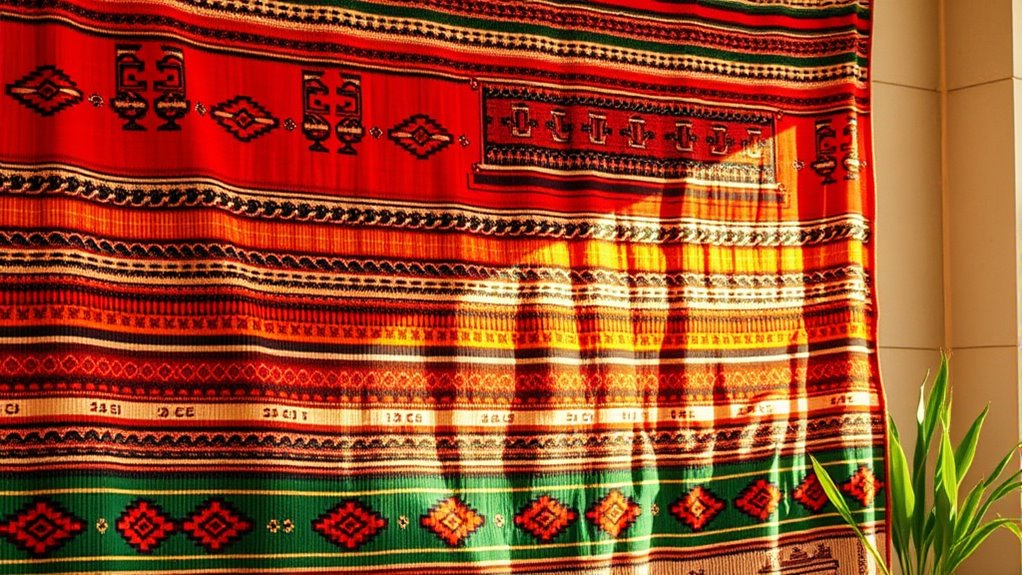
Indigenous colors carry deep cultural meanings that go beyond their visual appeal. These colors embody tribal symbolism, representing stories, spiritual beliefs, and social status within communities. Every hue is carefully chosen to convey specific messages, making color conservation essential for preserving cultural identity. When you incorporate indigenous colors into decor, you honor these traditions and respect their significance. Using traditional colors isn’t just about aesthetics; it’s about maintaining a connection to ancestral heritage. You must understand that each shade holds a purpose, whether to symbolize power, fertility, or protection. Respecting the cultural importance of these colors ensures that their use remains authentic and meaningful, safeguarding their significance for future generations. Color symbolism plays a vital role in understanding and preserving these indigenous traditions.
Common Indigenous Color Palettes and Their Origins
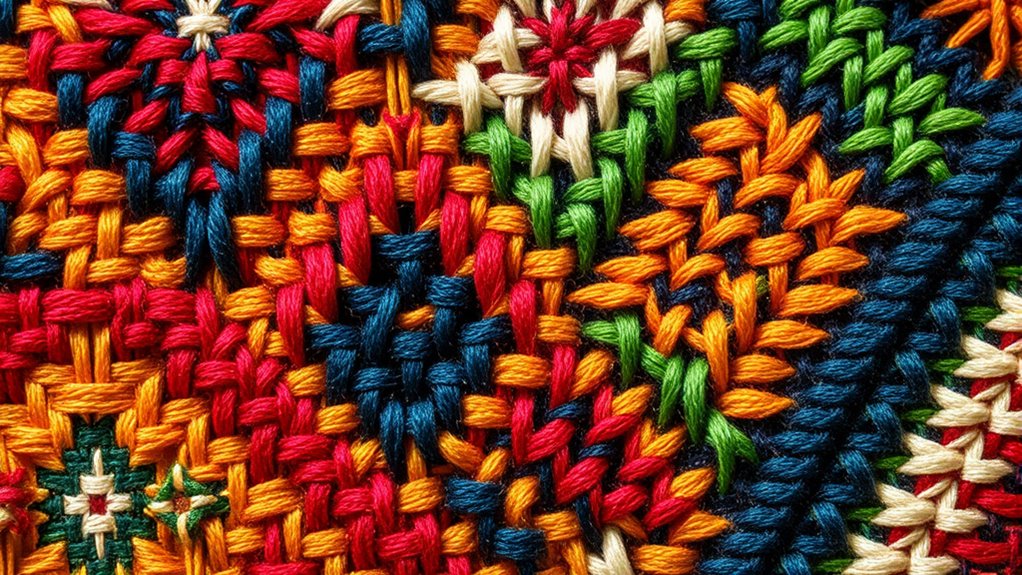
You’ll notice that many indigenous color palettes share common hues rooted in cultural meanings and natural resources. These palettes often vary by region, reflecting local environments and traditions. Exploring these variations reveals how colors serve as symbols of identity and heritage across different communities. Additionally, color symbolism plays a significant role in conveying cultural values and stories through these palettes.
Cultural Significance of Colors
Colors in indigenous palettes often carry deep cultural meanings that reflect history, spirituality, and social identity. You’ll notice that specific hues symbolize important values, beliefs, or natural elements, reinforcing cultural identity through color symbolism. For example, red may represent life, strength, or blood, while white signifies purity or spiritual connection. These colors are more than aesthetic choices; they embody stories, ancestral ties, and societal roles. By understanding the cultural significance of colors, you can appreciate how indigenous communities use their palettes to express identity and preserve traditions. Each color’s meaning is rooted in a shared history, making these palettes powerful symbols of collective memory and cultural resilience. Recognizing this enriches your appreciation of indigenous art and decor. Additionally, the use of these colors often intersects with cybersecurity concerns when sharing or documenting indigenous designs online, emphasizing the importance of respecting their cultural significance and protecting their intellectual property.
Regional Palette Variations
Regional palette variations stem from geographic color influences and regional color symbolism, shaping indigenous designs. For example:
- Desert regions often feature warm, earthy tones like ochre and terracotta, symbolizing land and survival.
- Coastal areas incorporate blues and aquas, representing water and ocean life.
- Forested zones favor greens and browns, reflecting lush landscapes and natural resources.
- Mountain regions display cool grays and whites, inspired by rocky terrain and snow caps.
These variations reveal how geography influences indigenous color choices, creating palettes that are deeply connected to local ecosystems and cultural identity. Recognizing local cultural influences can deepen your understanding of these color traditions. Understanding these regional differences enriches your appreciation of indigenous decor and its meaningful color use.
Symbolism Behind Specific Colors in Indigenous Cultures
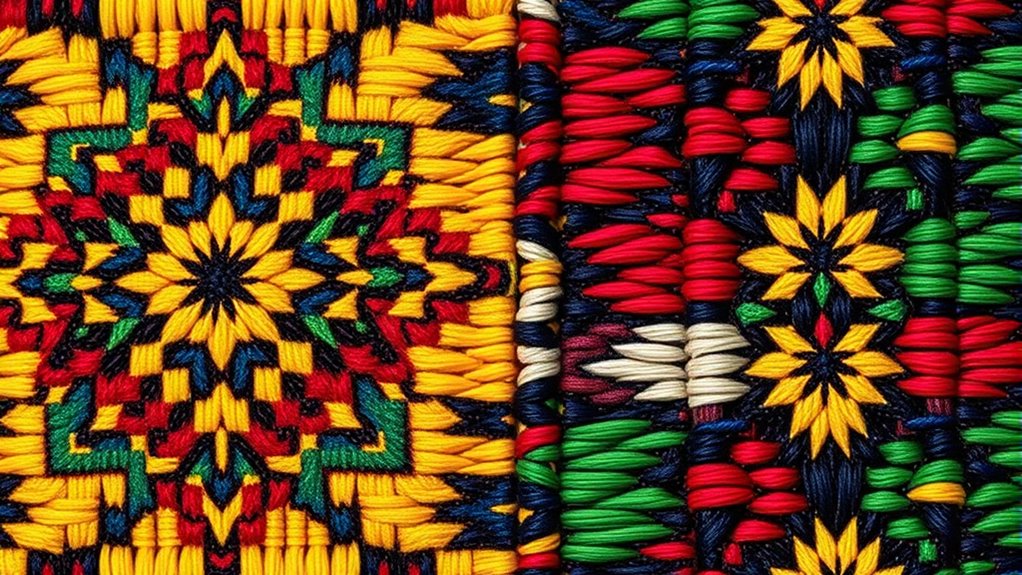
In many indigenous cultures, specific colors carry deep symbolic meanings that reflect their beliefs, values, and connection to nature. These meanings shape how colors are used in art, ceremonies, and daily life, revealing their rich symbolism. For example, red often signifies life, vitality, and spiritual energy, while blue can symbolize the sky, water, or peace. Green might represent nature and growth, and white can stand for purity or mourning. Understanding this color symbolism helps you appreciate the cultural significance behind indigenous palettes. Here’s a glimpse into these symbolic meanings: Signs of spoilage include off-smell, discoloration, and separation.|
| Color | Symbolic Meaning | Cultural Connection |
|---|---|---|
| Red | Life, energy, spiritual power | Vitality & Courage |
| Blue | Sky, water, peace | Calm & Spirituality |
| Green | Nature, growth | Fertility & Renewal |
| White | Purity, mourning | Peace & transition |
| Yellow | Sun, happiness | Energy & Wealth |
Respectful Ways to Incorporate Indigenous Colors in Your Home
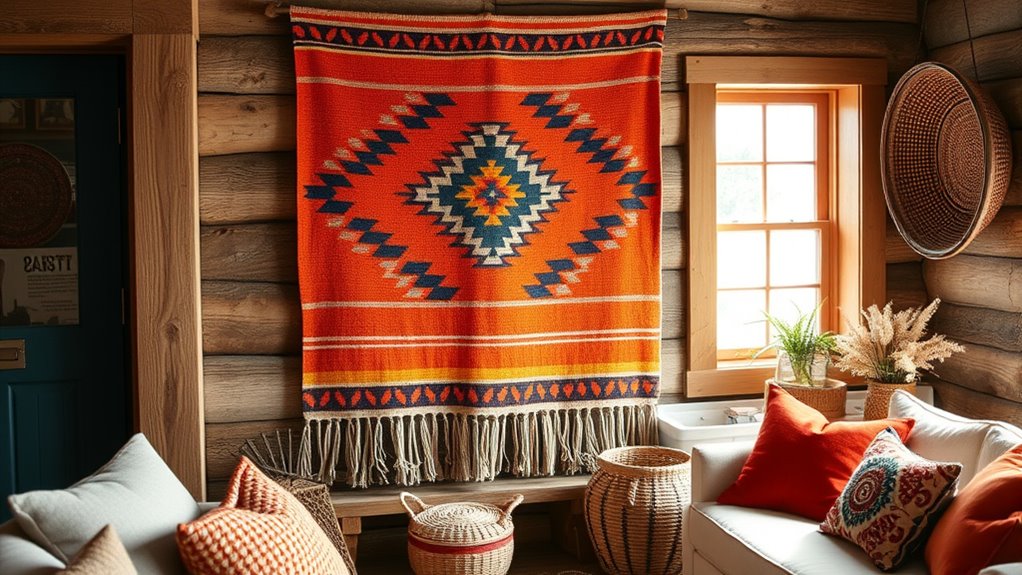
To respectfully incorporate Indigenous colors into your home, start by educating yourself about their cultural significance and the proper contexts for use. Avoid cultural appropriation by understanding which colors and symbols are sacred and when it’s appropriate to display them. To honor Indigenous cultures, consider:
Educate yourself on Indigenous colors’ significance and honor their cultural meanings with respectful, informed choices.
- Supporting Indigenous artists and artisans by purchasing authentic artwork
- Creating DIY indigenous art that respects cultural meanings and avoids stereotypes
- Using colors in ways that highlight their cultural importance without misrepresenting their origins
- Consulting with Indigenous communities or organizations to ensure respectful integration
- Recognizing the importance of cultural sensitivity when selecting and displaying Indigenous colors and symbols
Case Studies: Indigenous-Inspired Decor in Modern Spaces
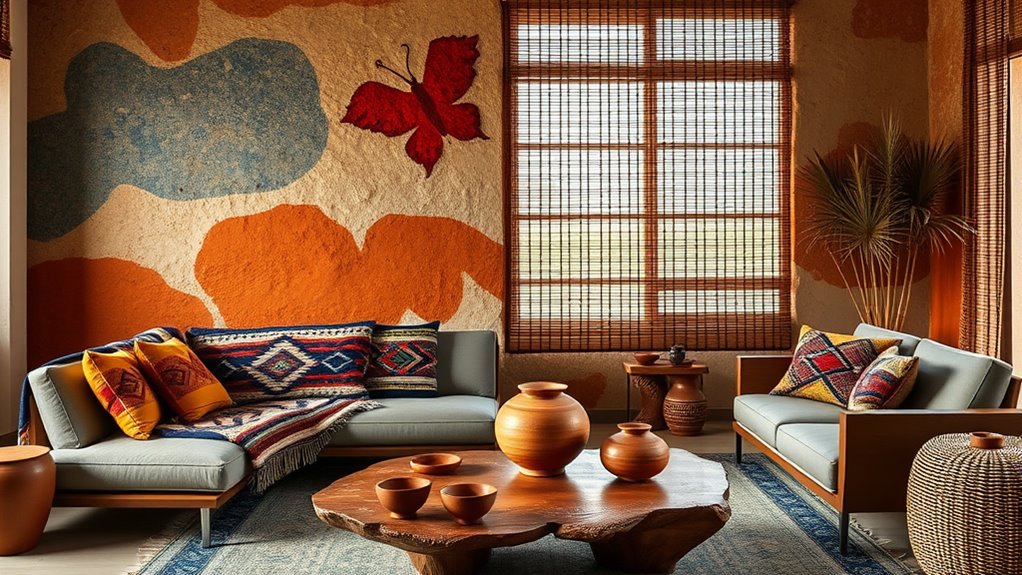
Many modern interiors showcase Indigenous-inspired decor that thoughtfully balances cultural appreciation with contemporary style. Designers often incorporate tribal design elements, such as bold patterns, natural textures, and vibrant color palettes, to create striking spaces. One example features a living room where Indigenous motifs are subtly integrated into furniture and accessories, blending tradition with sleek, modern lines. Another case highlights a dining area using contemporary adaptation of Indigenous colors, like earthy reds and deep blues, to evoke a sense of grounding and connection. These spaces demonstrate how thoughtful use of tribal design can honor Indigenous aesthetics while fitting seamlessly into modern homes. By drawing inspiration from authentic sources and adapting them thoughtfully, you can create spaces that celebrate cultural richness without appropriation. Additionally, understanding color palettes and their meanings can deepen the cultural resonance of your decor choices.
Preserving and Honoring Indigenous Art and Color Traditions

You can honor Indigenous art by respecting the cultural significance behind their colors and patterns. Preserving traditional craft techniques guarantees these vibrant expressions continue for future generations. It’s also essential to approach this appreciation ethically, giving proper credit and avoiding cultural appropriation. Additionally, understanding potential pitfalls in adopting new payment technologies can help ensure that cultural exchanges are conducted with respect and integrity.
Cultural Significance of Colors
Colors hold deep cultural significance in indigenous communities, serving as symbols of identity, spirituality, and tradition. They convey complex meanings through color symbolism, connecting communities to their ancestors and environment. When you honor these traditions, you respect the cultural identity embedded in their palettes. Recognizing color symbolism helps deepen appreciation for their artwork and practices. You’ll find that colors often represent essential concepts, such as: – Life and vitality, symbolized by vibrant reds and oranges – Spirituality and protection, conveyed through sacred blues and whites – Nature and harmony, reflected in earthy browns and greens – Courage and strength, expressed with bold blacks and reds Understanding these meanings helps preserve indigenous art’s authenticity. Using these colors thoughtfully in decor not only celebrates their cultural significance but also supports the ongoing legacy of indigenous traditions.
Traditional Craft Preservation
Preserving indigenous art and color traditions is crucial for safeguarding cultural identities and passing down ancestral knowledge. You play a vital role in supporting efforts to maintain traditional weaving and craft techniques that embody unique color palettes. By valuing and promoting these practices, you help ensure they remain vibrant for future generations. Many communities use specific dyes and methods that carry deep cultural meanings. To illustrate, consider the following table highlighting key aspects of traditional craft preservation:
| Technique | Cultural Significance | Preservation Challenges |
|---|---|---|
| Traditional weaving | Symbolic patterns | Modernization threats |
| Natural dyeing | Ancestral knowledge | Loss of plant sources |
| Handcrafting | Community identity | Economic pressures |
| Ritual practices | Cultural continuity | Lack of awareness |
Your support helps sustain these invaluable traditions, which are often rooted in traditional craftsmanship that has been carefully handed down through generations.
Ethical Cultural Appreciation
Respecting and honoring indigenous art and color traditions requires more than just appreciation; it demands an ethical approach that recognizes the value of these cultural expressions. You should prioritize cultural sensitivity by understanding the history and significance behind specific colors and designs. Practice ethical sourcing by supporting artisans and brands that collaborate directly with indigenous communities. Be mindful of the origin of the materials and ensure fair compensation for creators. Avoid cultural appropriation by educating yourself and respecting the context in which these colors are used.
- Support authentic indigenous artisans and businesses
- Educate yourself on cultural significance and boundaries
- Verify transparent, ethical sourcing practices
- Share knowledge responsibly without misrepresentation
Frequently Asked Questions
How Can I Ensure Authentic Representation When Using Indigenous Colors?
To guarantee authentic representation when using indigenous colors, you should prioritize cultural sensitivity and ethical sourcing. Respect the significance of the colors by researching their meanings and origins, and seek permission or collaborate with indigenous communities whenever possible. Always source materials ethically, supporting artisans and businesses that honor cultural traditions. This approach helps you use colors responsibly while honoring their cultural importance and avoiding misappropriation.
Are There Specific Tools or Resources to Identify Authentic Indigenous Color Palettes?
You can use digital color tools like Adobe Color or Coolors to explore authentic indigenous palettes. Additionally, cultural authenticity resources such as tribal websites, academic articles, and museum collections help you identify true colors and their meanings. By cross-referencing these tools and resources, you guarantee your use of indigenous colors respects cultural significance and maintains authenticity in your decor. Always verify sources to avoid misrepresentation.
What Are Common Mistakes to Avoid When Incorporating Indigenous Colors?
Think of incorporating indigenous colors like walking a tightrope—one misstep can cause harm. Avoid cultural appropriation by respecting origins, and steer clear of misinterpreting symbols that hold deep meaning. Don’t overgeneralize or use colors out of context; instead, do your research. Always seek authentic sources and, when possible, collaborate with indigenous communities to honor their traditions and guarantee respectful, meaningful decor choices.
How Do Indigenous Colors Vary Across Different Tribes and Regions?
You’ll notice indigenous colors vary widely across tribes and regions, reflecting unique tribal symbolism and regional dyeing techniques. For example, some tribes favor vibrant reds and yellows to symbolize life and energy, while others prefer earthy tones representing harmony with nature. These color choices are deeply rooted in cultural traditions, so understanding tribal symbolism and regional dyeing methods helps you respectfully incorporate authentic indigenous colors into your decor.
Can Indigenous Color Traditions Be Adapted for Commercial or Mass-Produced Decor?
You can adapt indigenous color traditions for commercial decor, but you need to prioritize cultural sensitivity and respectful representation. Focus on authentic design integration by consulting with indigenous communities or experts to ensure accuracy and honor the tradition. Avoid stereotypes or oversimplifications, and aim to support indigenous artisans. This approach helps preserve cultural significance while creating meaningful, respectful decor that celebrates indigenous heritage responsibly.
Conclusion
By embracing indigenous color palettes thoughtfully, you honor ancient traditions much like a steward tending a sacred flame. Respectful incorporation connects your space to a rich tapestry of history, culture, and meaning—reminding us that, like the enduring stories passed down through generations, these colors carry weight beyond aesthetics. When done with reverence, your decor becomes a living tribute, echoing the timeless beauty and profound significance of indigenous art.

